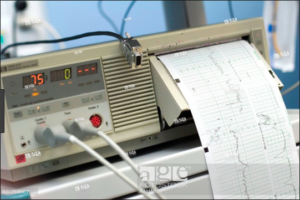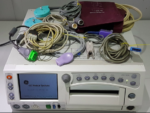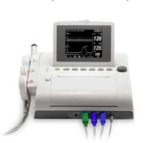Sampling of EFM Studies ~ the first 10 year (1975-85)
 The evaluation of continuous fetal heart rate monitoring in high-risk pregnancy
The evaluation of continuous fetal heart rate monitoring in high-risk pregnancy
AD Haverkamp, HE Thompson, JG McFee… – American Journal of …, 1976 – Elsevier
Abstract
Intrapartum electronic fetal heart rate monitoring of the high-risk obstetric patient is thought to improve the perinatal outcome. A prospective randomized study of 483 high-risk obstetric patients in labor was carried out comparing the effectiveness of electronic fetal monitoring (EFM) with auscultation of fetal heart tones.
The infant outcome was measured by neonatal death, Apgar scores, cord blood gases, and neonatal nursery morbidity.
There were no differences in the infant outcomes in any measured category between the electronically monitored group and the auscultated group.
The cesarean section rate was markedly increased in the monitored group (16.5 vs. 6.8 per cent in the auscultated patients).
The presumptive benefits of electronic fetal monitoring for improving fetal outcome were not found in this study.
…
…
Controlled trial of fetal intensive care
 P Renou, A Chang, I Anderson, C Wood – American Journal of Obstetrics …, 1976 – Elsevier
P Renou, A Chang, I Anderson, C Wood – American Journal of Obstetrics …, 1976 – ElsevierA fetal intensive care unit was formed at the Queen Victoria Memorial Hospital in 1972.
Because of some doubt concerning the value of fetal intensive care, a controlled clinical trial including all high-risk patients was performed. The trial clearly showed that intensive care is …
 An assessment of continuous fetal heart rate monitoring in labor: A randomized trial
An assessment of continuous fetal heart rate monitoring in labor: A randomized trial
IM Kelso, RJ Parsons, GF Lawrence, SS Arora… – American Journal of …, 1978 – Elsevier
Intrapartum continuous fetal heart rate monitoring has been routinely performed at the Jessop Hospital for Women for some years. However, no controlled trials had ever been performed to show its advantages over intermittent auscultation in low-risk patients. A …
 A controlled trial of the differential effects of intrapartum fetal monitoring
A controlled trial of the differential effects of intrapartum fetal monitoring
AD Haverkamp, M Orleans, S Langendoerfer… – American journal of …, 1979 – Elsevier
A controlled prospective study of the differential effects of intrapartum fetal monitoring on
mothers and infants has been conducted at Denver General Hospital, Denver, Colorado. A
total of 690 high-risk obstetric patients in labor were randomly assigned to one of three …
 A controlled trial of fetal heart rate monitoring in a low-risk obstetric population
A controlled trial of fetal heart rate monitoring in a low-risk obstetric population
C Wood, P Renou, J Oats, E Farrell, N Beischer… – American Journal of …, 1981 – Elsevier
A controlled of fetal rate (FHR) monitoring. in a low-risk obstetrics was carried out in 989
patients at the Maternity Hospital and Victoria Medical Centre. The use of monitoring failed
demonstrate any improvement perinatal outcome. Monitoring was associated with an …
 A randomized trial of electronic fetal monitoring in preterm labor
A randomized trial of electronic fetal monitoring in preterm labor
DA Luthy, KK Shy, G Van Belle, EB Larson… – Obstetrical & …, 1987 – journals.lww.com
Abstract s: Electronic fetal heart rate (FHR) monitoring was developed to improve detection
of intrapartum fetal distress, but its efficacy has never been fully demonstrated. In 1979, a
national task force recommended randomized clinical trials of patients with high-risk …
 The Dublin randomized controlled trial of intrapartum fetal heart rate monitoring
The Dublin randomized controlled trial of intrapartum fetal heart rate monitoring
D MacDonald, A Grant, M Sheridan-Pereira… – American journal of …, 1985 – Elsevier
In a randomized controlled trial involving 12,964 women, a policy of continuous electronic
intrapartum fetal heart monitoring was compared with an alternative policy of intermittent
auscultation, both policies including an option to measure fetal scalp blood pH. Women …
 Intrapartum fetal heart rate monitoring in a combined low-and high-risk population: a controlled clinical trial
Intrapartum fetal heart rate monitoring in a combined low-and high-risk population: a controlled clinical trial
S Neldam, M Osler, PK Hansen, J Nim, SF Smith… – European Journal of …, 1986 – Elsevier
In a prospective clinical randomized investigation 487 women had the condition of the fetus
during labour supervised by means of stethoscope (AUS), while 482 women went through
labour under surveillance of electronic fetal monitoring, cardiotocography (EFM). 349 …
 A prospective comparison of selective and universal electronic fetal monitoring in 34,995 pregnancies
A prospective comparison of selective and universal electronic fetal monitoring in 34,995 pregnancies
KJ Leveno, FG Cunningham, S Nelson… – … England Journal of …, 1986 – Mass Medical Soc
We investigated the effects of using intrapartum electronic fetal monitoring in all
pregnancies, as compared with using it only in cases in which the fetus is judged to be at
high risk. Predominant risk factors included oxytocin stimulation of labor, dysfunctional labor …
 A randomized trial of intrapartum electronic fetal heart rate monitoring versus intermittent auscultation.
A randomized trial of intrapartum electronic fetal heart rate monitoring versus intermittent auscultation.
AM Vintzileos, A Antsaklis, I Varvarigos… – Obstetrics and …, 1993 – europepmc.org
OBJECTIVE: To determine whether continuous intrapartum electronic fetal heart rate
monitoring (EFM) is associated with decreased perinatal mortality and morbidity compared
with intermittent auscultation. METHODS: The study was conducted simultaneously at two …
